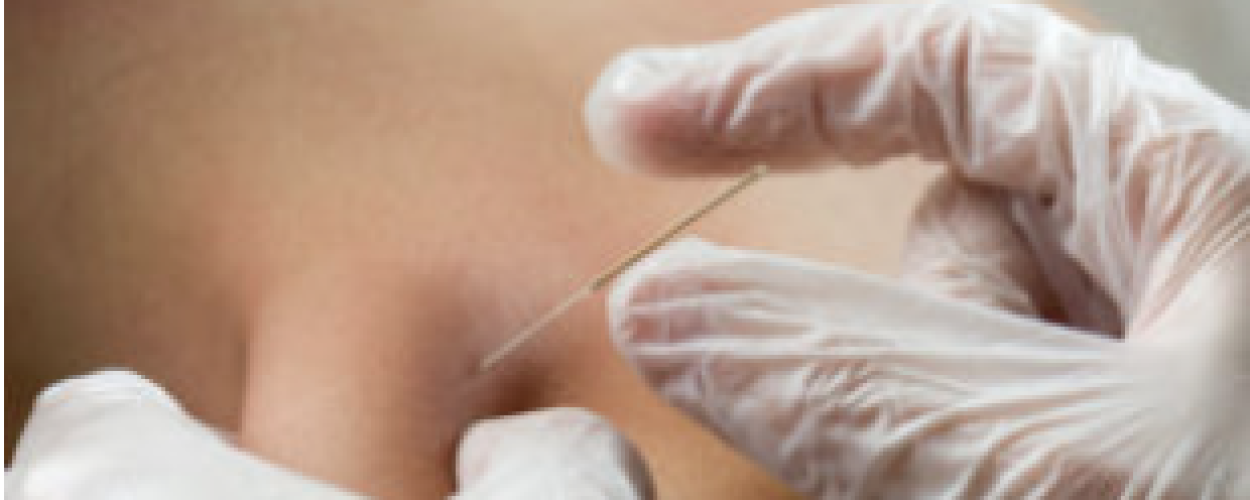There are many buzzwords floating around the pain relief world lately. “Dry needling” is one of them, yet not many people are informed about this method of musculoskeletal pain management. As a healthcare practitioner, it is important to me to provide accurate information and educate my community about controversial topics so that each person can make empowered decisions for their health and wellness. To be clear, I want to start by sharing that I know people who have benefited from dry needling.
What is Dry needling?
The term itself is meant to indicate that no medicine is injected into the body, thus the needle is “dry.” Also known as trigger point needling or intramuscular manual therapy, this technique does not follow the same ancient Chinese theory as acupuncture and is typically practiced by physical therapists, chiropractors, and even massage therapists to eliminate pain in inflamed myofascial “knots” with different needling techniques. Acupuncturists use what are known as “Ashi points” in the same way, although these points were identified in Chinese medicine thousands of years ago. Many of these points occur on the back, neck, and chest.
Read also: Dry Needling vs Acupuncture: Which is Best for You?
Education for Needed for Dry Needling
Though both practices involve the insertion of stainless steel filiform needles into the skin, the educational requirements to practice dry needling are very different than what is required to become an acupuncturist. To earn a Master’s level degree in acupuncture involves three to four years of academic training culminating with 600 hours of clinical practice for a total of no less than 1400 hours of acupuncture principles. This course of study includes diagnostic and pulse theory in addition to over 150 hours of point location practice, biomedical sciences curriculum, and attunement to the physical and energetic needs of each person. Occupational hazard management and needle technique standards while under the supervision of licensed acupuncturists in a nationally accredited institution are part of the clinical requirements for acupuncture students. Insertion of a needle is an art with the intention to stimulate the movement of qi, our vital energy. State regulations and a national certification agency govern the rigorous examination, licensing, and continuing education process for acupuncturists.
Scope of Practice of Dry Needling
Recent debate around whether dry needling is actually acupuncture or if dry needling is beyond the scope of practice for physical therapists, chiropractors, etc. is the central concern among healthcare professionals. Acupuncture originates from a holistic view of the body, mind, and spirit and numerous research conclude it is indicated in the treatment of many physical and emotional concerns. Dry needling works on one isolated pain area and has proven efficacy for a variety of musculoskeletal conditions.
State Regulations and Insurance of Dry Needling
Each state regulates the practice of dry needling by physical therapists differently. It is entirely banned in some states, while others have very few regulations in place. California, Hawaii, Idaho, New York, and Utah have ruled against the practice of dry needling by physical therapists. In most states, only medical doctors, dentists, and acupuncturists are able to purchase and practice with acupuncture needles. In fact, the Food and Drug Administration prohibits the sale of acupuncture needles, classified as Class II prescription medical devices, to anyone other than a licensed acupuncturist. In order for a physical therapist to practice dry needling, a weekend education course is required, though these courses are not evaluated for proficiency in professional standards, nor is any type of supervision or testing mandated. The state of Colorado requires 46 hours of training for physical therapists to practice dry needling. No additional regulations or credentials are in place to treat pain by the insertion of a needle into a muscle at the site of certain trigger points.
Late in 2018, new CPT codes for dry needling were approved that are required for Chiropractors and Physical Therapists to bill insurance. These codes are expected to be adopted into practice in late 2019. This is a great victory for healthcare professionals in those fields, yet acupuncturists still have difficulty with insurance coverage and reimbursement.
What are The Health Risks of Dry Needling?
Both acupuncture and dry needling share some side effects, including possible soreness at the insertion site and light bruising. The World Health Organization classifies pneumothorax caused by acupuncture as very rare.
Adverse events related to dry needling are at the center of numerous lawsuits across the country. The most common of these is pneumothorax, a collapsed lung from a puncture causing air to fill the chest cavity. The risk of pneumothorax is a realistic concern for acupuncturists, as well as several important points found on the chest, shoulders, and neck. Pneumothorax can result in death. Needle size, incorrect needle insertion depth, angle, and direction are the primary causes of pneumothorax and other adverse events, such as nerve damage.
Over the last 15 years, the incidence of dry needling adverse events has increased, including pneumothorax resulting in a life-threatening infection for an Olympic athlete in 2006 from Canada and in Maryland, a severe nerve damage case in 2012 from incorrect needle insertion causing extreme pain and mobility impairment to the left leg. Another notable case in Colorado occurred in 2013 when a teen Olympic skier suffered from pneumothorax after treatment by a physical therapist.
This information is for educational purposes. I encourage you to do your own research regarding dry needling and be an advocate for your own health. Please don’t hesitate to call or email our office with questions or concerns!
Report an injury or learn more about injuries from dry needling
This blog post was co-written by Brittany Sanelli and Mindi Counts.

